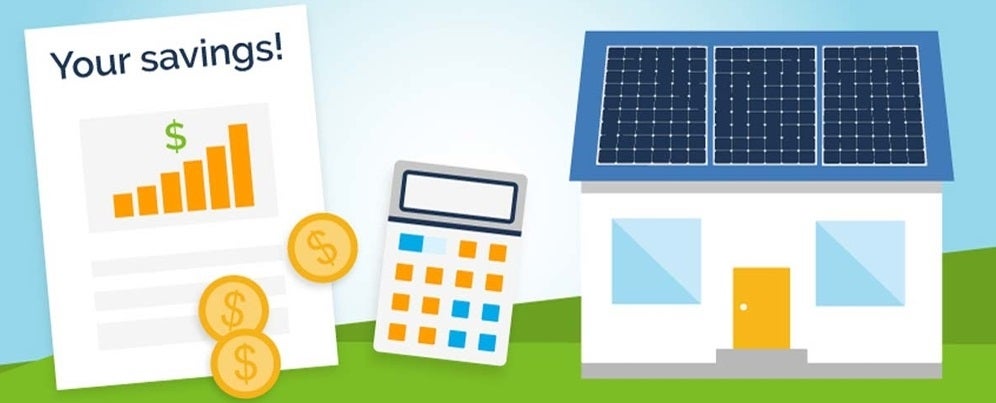
Adding solar panels to your home results in many benefits, but the one that everyone wants to know about is the Return on Investment (ROI).
What makes solar panels unique among other home improvement projects is that they pay back their initial cost - through savings on your energy bill.
Calculating how much you can save over time can tell you whether your investment in renewable energy is worth it from a financial perspective. To do that, financial analysts use a tool called “internal rate of return,” or IRR, that analyzes the financial returns of an investment.
Comparing the IRR you can expect from your solar installation with the rate of return from your best alternative is how you can figure out if solar power is a good investment for you.
How solar panels pay back their investment cost
There are two ways solar panels make money for the people who own them.
The first is through electricity bill savings. Electricity usage is measured in kilowatt-hours (kWh), and you need a certain amount of kWh to run your home’s appliances and devices throughout the day. Choosing a solar system that meets your needs can virtually eliminate your electric bill (other than small fixed charges needed to connect to the grid).
The second way solar panels save money is through solar incentives. Tax credits and ongoing bonus payments for solar energy can lead to big financial gains if you live in the right state.
The right mix of utility bill savings and incentives can make an investment in solar far better than the returns you could see by investing in the stock market.
Energy bill savings
Energy generated by solar panels is first used to power the home during the day.
Then, if more energy is produced than the home needs, it’s sent onto the grid. In most states, that excess electricity is counted as a credit towards kWh that the home needs when the sun isn’t shining - an incentive program called net metering.
In states with full-retail net metering, every kWh of electricity is worth the same amount. In states without net metering, the excess electricity generated by solar is credited at a lower rate, also known as the avoided cost rate.
While you’ll get the highest return on your solar investment if you live in a state with strong net metering laws that mandate full-retail net metering, you’ll still see significant savings living in a state that implements the avoided cost rate.
Solar incentives
Even if you live in a state without net metering, going solar can still be a good financial decision if the available incentives are good enough. And in a state with net metering, incentives can send your ROI through the roof.
The most famous solar incentive that is available to all Americans is the federal clean energy tax credit. If you install solar panels, the federal government will reimburse you for 30% of the costs through your tax return. This only works if you owe that amount (or more) after all other credits are taken into account. You can also carry over any unused portion of the credit to subsequent tax years.
If you install solar panels before the end of 2032, the federal government will reimburse you for 30% of the costs through your tax return. This only works if you owe that amount (or more) after all other credits are taken into account. You can also carry over any unused portion of the credit to subsequent tax years.
Other solar incentives include rebates, which reduce upfront installation costs, as well as SRECs and performance payments, which earn system owners extra money for every kWh their panels produce.
There are also incentives like property tax exemptions that eliminate the payment you would otherwise pay for, for the value added to a home by solar panels.
When calculating solar panel ROI, we don’t usually include these benefits, because they can’t be defined as easily as those based on system size and production.
How to calculate ROI for solar panels
Things to know about solar panel ROI:
- The average ROI on solar panels in the United States is about 10%
- Solar panel ROI varies widely based on location and the specifics of your home
- If you have a solar estimate with cost and savings projections, you can use modern spreadsheet programs to make ROI easy to calculate
The ROI of solar panels can be calculated by taking net installation cost after one-time incentives versus expected electric bill savings and ongoing incentives over time.
Let’s be clear here that solar ROI is not the same thing as payback time. Knowing how long it will take for solar panels to pay back their cost is only half the information necessary. The other half has to do with the rate of return you can expect, based on average expected savings over the lifetime of your solar system.
This is where the internal rate of return, or IRR, comes in. According to Investopedia, IRR is “a discount rate that makes the net present value (NPV) of all cash flows equal to zero in a discounted cash flow analysis”.
That’s a complicated way of saying “it’s the rate you’d need to earn on an investment to match the return you’d expect to get from what you’re considering now (in this case, a home solar energy system).”
The formula to calculate it looks like this:
Image source: Investopedia
Fortunately, you don’t need to use that complicated formula to figure out solar panel IRR, because the SolarReviews solar panel calculator can do the work for you. Here’s a video that explains how to use our calculator to determine the IRR of your solar system based on the numbers in an installer’s quote:
However, if you’re the kind of person who likes to do the math yourself, you can figure out IRR by putting all the variables into a modern spreadsheet program.
The IRR function in spreadsheet programs
Thanks to programs like Excel and Google Sheets, calculating IRR is actually pretty simple.
First, lay out a column with 25 cells that represent each year (most solar panels are warrantied for 25 years).
In the first cell, start out with system cost after upfront incentives, which represents the amount you invested. Subtract from that all first-year tax incentives and savings on electricity costs (kWh produced multiplied by your retail rate in net metering states). The result should be a negative number that represents the net first-year investment in your solar panel installation.
For each of the next 24 years, the cells should contain positive numbers equal to the value of ongoing energy bill savings and incentives. Expect solar energy production to go down by about 0.5% per year, and the cost of electricity from the utility company to increase by around 2% per year (electricity cost increases could be more or less depending on where you live).
If your PV system will be using a central solar inverter, expect to replace it somewhere between Year 10 and 15, and reduce that year’s profits by about $1,500. On the other hand, if you’ll be using microinverters, they should last 25 years (and come with warranties for that period), so you don’t have to add that additional expense.
For example, let’s say the values you’re looking at here are in cells C2 through C26 in your spreadsheet. In cell C27, type “=IRR(C2:C26)”. The program will do the rest, and will output a percentage.
Here are the calculations for a home solar panel system in California:
The image above shows how a 5.2-kW solar system starts at an estimated total cost of $16,640, which is then reduced by $4,992 because of the federal tax credit and $1,582 in electricity bill savings over the first year.
The savings add up over 25 years, resulting in $46,031 total profit and an IRR of 18.64%.
Comparing the ROI of solar energy to other investments
So is that 18.64% IRR any good? In order to determine what IRR means you have to compare it to your next-best investing option.
Putting money in your sock drawer returns 0%, because you don’t earn any interest on money that’s socked away (ba dum tss). Open an online savings account and you might get 3.5% back per year. But the benchmark financial experts usually use to compare investments is the historical return of the stock market.
The S&P 500 has returned about 8% per year over the past 90+ years. That means, instead of purchasing solar panels for your home, you could buy shares in the SPY index fund that tracks the performance of the S&P 500, and probably earn about 8% over the next 25 years.
Considering that our sample calculations for California showed an estimated 18.6% annual return, we estimate that an investment in a solar installation there is more than twice as good as a similar investment in a broad index fund like SPY.
How to get the best price when you buy solar panels
Every state is different, and every home within a state is also different, so our example for a California home above probably won’t match your experience entirely.
The best way to get an accurate estimate for your own ROI is to use our solar panel calculator to get estimates of cost, incentives, and savings. Once you’ve gotten that information, you can use the calculator to get quotes from solar installers near you.
It’s important to compare multiple quotes from different installers. Look at their estimates for solar panel cost, future energy costs, and savings.
A great solar installer should be able to show you the estimated payback period and IRR of your solar investment, but if they don’t, you can use the method we outlined above to do your own ROI calculation and go solar with confidence!
Key takeaways
- Solar is unlike other home improvement projects because it directly pays back its cost over time and adds value to your home.
- Some states offer cash payments for solar energy that can increase your returns.
- In most states, an investment in home solar panels can beat the expected returns of an investment in the stock market.
- The key to good solar ROI is state policies, electricity prices, and getting multiple quotes to find the best value.
